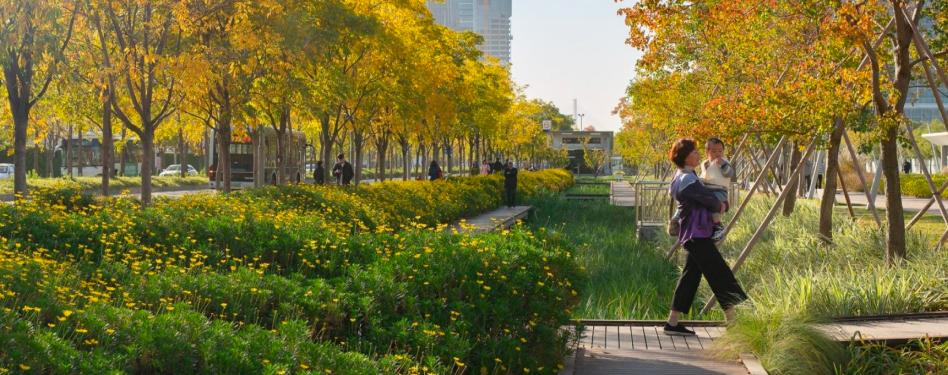
Feature image: Xuhui Runway Park. Photo credit: Sasaki.
The current SITES rating system for new construction projects has been vital in laying the foundation for protecting and restoring ecosystem services, fostering resilience, and prioritizing the health and well-being of a community. Today, over 1.2 billion square feet of new development projects in 17 countries are participating in SITES.
However, there are many more preexisting landscapes seeking these same goals. We can learn from them and recognize them as leaders. Based on growing interest in addressing this gap in the market, GBCI is now expanding its offerings to existing, built landscapes and infrastructure.
We are seeking partners and projects to collaborate on this new pilot, SITES for Existing Landscapes. It applies to all types of projects—parks, university campuses, office parks, streetscapes, hotels and resorts, residential and mixed-use developments—and all kinds of subject matter experts, in site operations, land management and landscape performance assessment.
Can I get an overview of the SITES for Existing Landscapes pilot?
Absolutely! The SITES team shared details on the pilot in a video.
How can I register my project for the pilot?
SITES is accepting new projects on a rolling basis. If you are ready to register a project, let us know. We are currently offering a promotional discount to the first 25 projects that register.
What can projects expect from the experience?
- Projects will follow custom pilot guidance, which is an adaptation based on the current SITES v2 rating system. The guidance explains how a project will evaluate and report on sustainable site management practices and monitor the social, economic and environmental benefits of that landscape.
- Projects will be in the forefront of co-developing and refining this guidance by sharing their implementation feedback with GBCI on its benefits and gaps. GBCI will assess the feedback received from project teams and refine the guidance document where needed. We will finalize and release the final SITES adaptation for existing landscapes based on the feedback shared by pilot projects and subject matter experts.
- Successful projects can earn recognition and SITES certification for their actions, and their leadership will be promoted by GBCI. A case study of the project will also be posted on the SITES website with other SITES-certified projects around the world.
What is the value of SITES for Existing Landscapes certification?
Demonstrate sustainability leadership with functional landscapes.
Pursuing certification recognizes the sustainable actions you have implemented and promotes your project as a much-needed example of sustainability with a wider audience. Additionally, the certification can improve your landscape’s performance and find new pathways to carbon mitigation that can distinguish your project or firm as a sustainability leader.
Improve your project’s resilience using natural climate solutions.
Studies show that natural climate solutions can offer up to 37% of the mitigation needed between now and 2030 to keep global temperature rise below 2°C. As the most recent IPCC report has stated, urban nature is particularly important in cities, which are home to 55% of the world population and expanding.
Urban areas are particularly vulnerable to climate-related extreme weather events, but natural spaces are one of the most powerful tools for minimizing damage and building for resilience. Landscape performance increases as relationships between soil, vegetation and organisms mature over long periods of time, becoming more complex, interdependent, regenerative and resilient.
SITES for Existing Landscapes will focus on ongoing site management and monitoring to ensure landscapes are functional and regenerative for the long term—and can continue to bounce back when they are most needed.
Measure your project’s environmental, social and economic impacts.
Sustainability is defined in many ways—carbon neutrality, net zero water, ecosystem services, quality of life—yet it cannot be achieved without considering the landscape. The more we can demonstrate the benefits of sustainable landscapes in different terms, particularly quantifying those benefits and their value, the more landscapes and nature-based solutions will be prioritized and the better they will be funded—and the more resilient, healthy and regenerative our communities will become.
While designing and constructing sustainable landscapes lays a critical foundation for site sustainability, ongoing land management and optimized site performance of our outdoor spaces is where we can secure long-term sustainability and strategically adapt to changing conditions.
We look forward to working with you in a new era of high-performance landscapes.
Do you have further questions or want to enroll in the pilot? Reach out to us directly.
